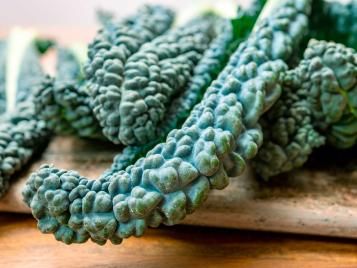

How to grow Cavolo Nero
‘Cavolo Nero’ is a variety of kale, closely related to broccoli, cauliflower and cabbage. It has the same characteristic fleshy thick green leaves and health benefits as other plants in the Brassica family, such as being a great source of Vitamin C and iron. Cavolo Nero kale has a long growing season, and has different needs as it matures - read on for our top tips on how to grow Cavolo Nero.
Types of Cavolo Nero to grow
Cavolo Nero translates as ‘black cabbage’ in Italian and is sometimes called this, as well as ‘black Tuscan palm’ or ‘dinosaur kale’.
The leaves are very dark green - nearly black – and are flat and strap-like, but with a bumpy texture resembling that of dinosaur skin. The plant also grows upright with the leaf tips peeling over like a palm tree.
Cavolo Nero has an earthier and sweeter flavour than other types of kale. It is very well regarded in famous kitchens across the culinary world, where it is used cooked in pasta dishes, stir-fries and soups, as well as raw in salads.

What you’ll need to grow Cavolo Nero
If growing from seed, sow between March to May. You will need:
- A pot or seed tray
- Seed compost, such as Levington® John Innes Seed Compost
- Watering can with fine rose
- Cavolo nero seeds
- Loosely fill the container with seed compost.
- Water the compost well, allowing it to drain away and the compost to fall beneath the lip of the container.
- Place the Cavolo Nero seeds on top of compost, allowing 1cm between them.
- Cover the seeds with more compost, allowing a small gap between the surface and the lip of the container.
- Water again, and keep well watered.
By June, the seeds will have germinated and will be ready for pricking out to individual pots. You will need:
- Pots
- Compost, such as Miracle-Gro® Peat Free Premium Fruit & Vegetable Compost
- Watering can with fine rose
- Dibber or an upturned pencil
- Seedlings
- Loosely fill each pot with compost.
- Water the compost, allow to drain away, and use the dibber or pencil to make a deep hole in the middle of each pot of compost.
- Gently tease the seedlings apart, and place one in each pot of compost, in the middle of the hole. The bottom leaves of the seedling should be just above the top of the hole.
- Add more compost to the hole and around the stem of the seedling, water again, and leave to grow on, keeping well watered.
In July, the Cavolo Nero plants can be transplanted to their final positions. They are the perfect plant to transplant out to fill the gaps left by recently harvested garlic and broad beans. In optimum growing conditions each plant can grow up to 1m (3') in height and width, so allow plenty of space between them. Simply:
- Create a hole in the soil big enough for the seedling and rootball.
- Fill the hole with water, allow it to drain away, and then place the seedling in the hole and backfill with soil.
- Water well until established and showing signs of new growth.
Where to plant and place your Cavolo Nero
Cavolo Nero can be grown in containers, but will need to be watered and fed more frequently to provide the plant with the same conditions as open soil. It prefers light and sandy soil with good drainage.
The bold and distinctive, large shape of Cavolo Nero gives structural interest to any border or vegetable patch. Plant them with shorter, brightly coloured plants in front, where the contrasting tones of their dark green blistered leaves can look stunning.
They like full sun to partial shade, but enjoy cold weather, so grow them outside rather than indoors. They really do look spectacular against a cold, white backdrop of snow or frost.
Caring and nurturing your Cavolo Nero
Regularly water Cavolo Nero in warm weather, adding a mulch of Miracle-Gro® Peat Free Premium Fruit & Vegetable Compost once or twice during the growing season to help the soil to retain moisture.
The plant is very hardy to cold weather, and the flavour of Cavolo Nero is said to improve after a few frosts. Harvest from October through to April, always leaving some green growth on the plant. Harvest the bottom outer leaves first, as new growth will sprout from the top, centre of the plant.
Remove any flower shoots which appear whilst you are still harvesting leaves. Allow the plant to flower in early spring, once you have finished harvesting leaves from the plant, to provide a source of nectar and pollen for bees and other pollinators.
Common pests and diseases with Cavolo Nero
Why are the leaves of my Cavolo Nero shredded and disappearing?
Caterpillars of the cabbage white butterfly will quickly strip green leafy growth from Cavolo Nero. Prevention is better than cure - add fine netting as soon as they are planted out, to prevent the butterflies from landing on them and laying eggs.
Why are the leaves of my Cavolo Nero covered in tiny pinholes?
Flea beetles love munching on Cavolo Nero leaves, making it look unattractive. Cover with fine netting or horticultural mesh from the moment they are sown. Encourage natural predators such as ladybirds and ground beetles, or spray with BugClear™ Fruit & Veg. However, tolerate it where possible - although it doesn’t look nice, the leaves are still edible.
Why are the leaves of my young plants disappearing, with shiny, slimy mucus left in their place?
Slugs and snails can devastate young Cavolo Nero plants, so protect from these pests by following our top tips.
What are the groups of flat grey-white bugs on the underside of the leaves of my Cavolo Nero?
Cabbage whitefly look unpleasant, but do not usually do much damage to a plant. Tolerate them as far as possible, and wash off prior to eating.
What are the groups of tiny green bugs on my Cavolo Nero?
Aphids suck sap from a plant, and have a particular taste for new, fresh growth. They can limit the production of new leaves, so should be tackled. Squish by hand, and encourage ladybirds and hoverflies, which will feast on them.
Frequently asked questions about Cavolo Nero
Do I need to protect my Cavolo Nero from birds?
It’s a good idea to do this, as birds like to east brassicas. However Cavolo Nero seems to appeal slightly less than other varieties, so you might be lucky! Place netting or humane bird scarers nearby if you are worried.
Can I eat Cavolo Nero raw?
Yes, Cavolo Nero can be eaten raw.
Is Cavolo Nero safe for dogs and other pets to eat?
Cavolo Nero is not known to be toxic to dogs, guinea pigs, rabbits, tortoises or bearded dragons. However, it is very rich in iron, so feed sparingly, and if in any doubt, check with your vet first.
Can Cavolo Nero be frozen?
Yes, blanch prepared leaves in boiling water for 1-2 minutes, and then immediately cool in ice cold water. Place in the freezer and add to dishes as needed.
Key features of Cavolo Nero
| Botanical Name | Brassica oleracea (Acephala Group) ‘Cavolo nero’ |
|---|---|
| Plant Type | Annual |
| Family | Brassicaceae |
| Sun Exposure | Sun to partial shade |
| Soil pH | Neutral to alkaline |
| Harvesting Time | October - April |
| Flower Colour | Yellow |




